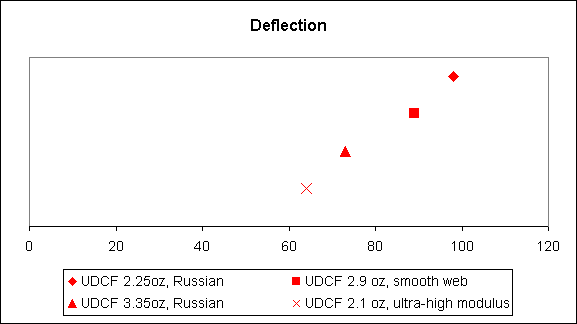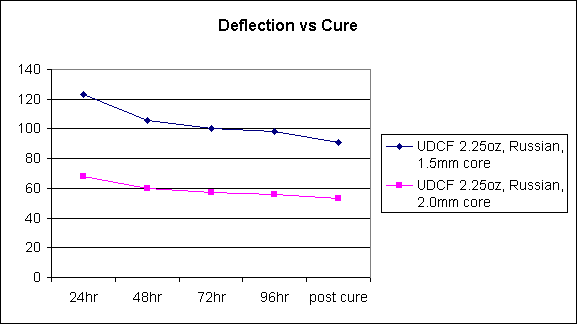Materials
There are a lot of materials out there to choose from, and much variety to be had with any given one. I set out to learn more about the various materials by making a series of test strips. The test strips have a core of 1.5mm Rohacell foam, they are one inch wide, and 12 inches in length. The goal is to have something easy to fabricate that lets me compare two different materials.
Deflection
One of the most important things we're concerned with in making composite booms is stiffness. The best stiffness comes from using unidirectional carbon fiber, but there are many different ones to choose from. In this experiment I built test strips with several different unidirectional carbon fiber products, subjected them all to the same loading conditions, and measured how many thousandths of an inch each of them deflected under load.

What we see here is not surprising. With one exception, the higher the weight of the material, the less the strip deflects. The relationship between deflection and material weight seems to be fairly linear. Use the lightest weight material that gives you the stiffness you need.
Most carbon fiber products available to the hobby community have about the same "tensile modulus", a measure of how well the fibers resist being stretched. I was able to get a sample of "ultra high modulus" carbon fiber tow to test with. It was very difficult to use, because it's not in a sheet form, but as you can see it has better stiffness than all the other products tested, even though it was lighter than all the rest. Don't count on seeing this in the stores anytime soon, a two pound spool will run you $500!
Deflection, thickness, and cure
In this test I made two test strips with identical material, but varied the thickness of the strip to find out how much impact the thickness of a boom has on its stiffness. I also measured the deflection several times to see how it changed with time as the epoxy cured.

The thickness of the boom has a significant impact on stiffness. When the thickness was reduced 25 percent, deflection increased by around 40 percent. This is one of the key trades made in designing an mta. There's only "so thin" you can go before the boom starts flopping around on the launch, or loses its tune all the time.
The graph also shows that, to a certain extent, epoxy gets stronger the longer it cures, and this results in less deflection. The initial deflection is over 20 percent higher than that measured after four days have passed.
The passage of time allows the epoxy to cure more thoroughly, but heat helps as well. After the deflection changes had leveled off, I put both strips in the oven at 200F for a couple hours, this is called "post curing". As you can see, the post cure resulted in a few percent better stiffness. Depending on the epoxy system used, post curing may have additional benefits such as increased fracture resistance.